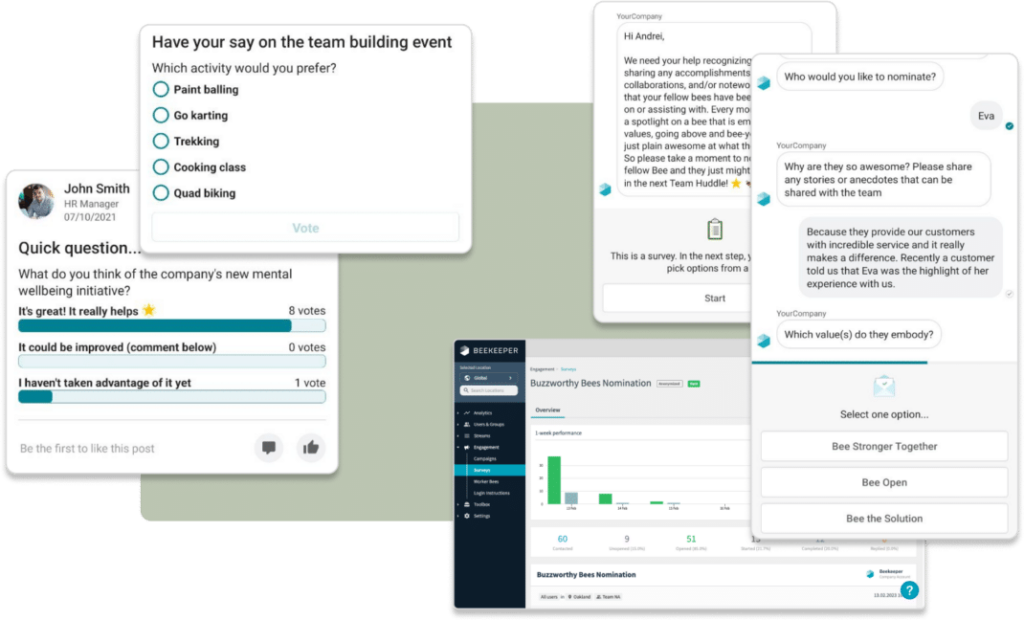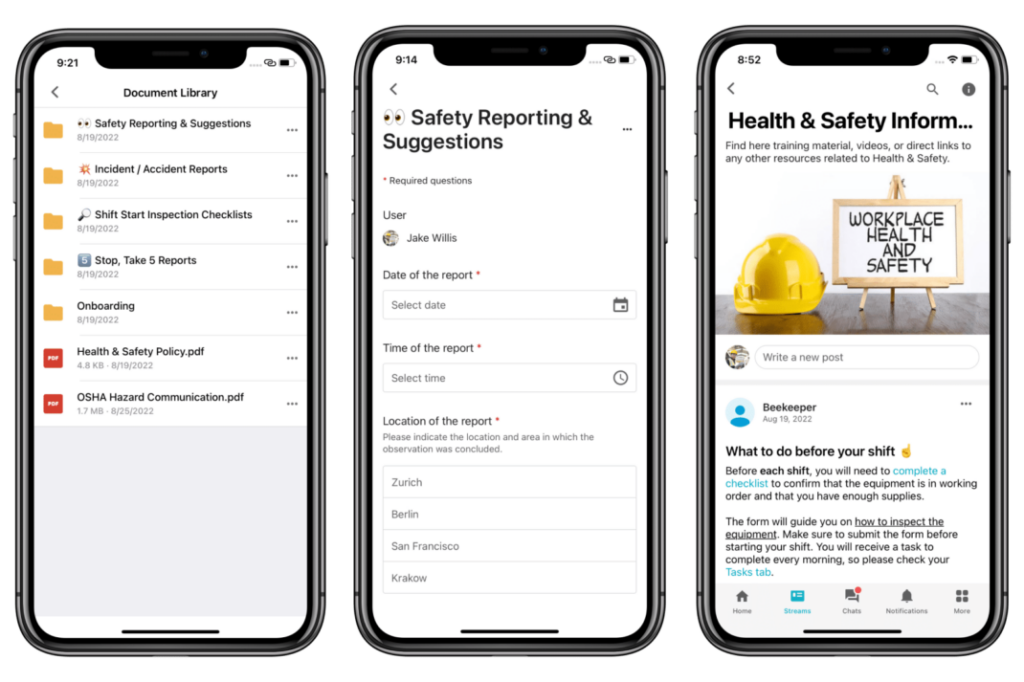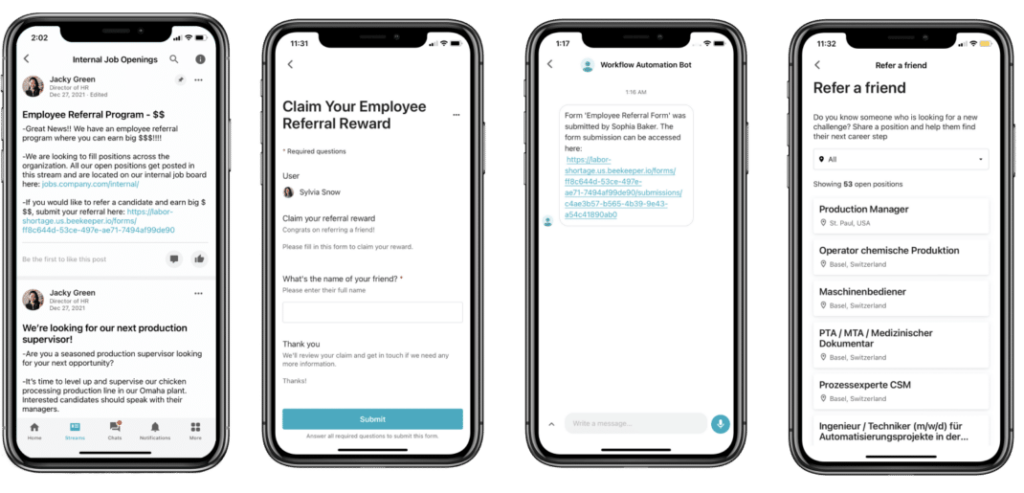Spark Engagement: 25 Company Intranet Content Ideas

You’ve found the perfect intranet tool for your staff. Now, you need some intranet content ideas to engage them and keep them coming back! Don’t worry: Beekeeper has some tried and true intranet ideas for content that will keep your workforce active and engaged, and even allow them to contribute their own ideas.
What Makes Intranet Content Engaging?
What exactly is going to grab your workforce’s attention and get them to be active readers, and contributors, on your workforce app like Beekeeper? Creating engaging ideas for intranet content is crucial for ensuring that employees are informed, motivated, and connected within the organization.
Here are some guiding points to create engaging content:
- Relevance: Content should resonate with employees and the work they do
- Interactive content: Gamify your content with pools, quizzes, and discussion forums
- Visual appeal: Use eye-catching tools like images, videos, and infographics
- Personal touch: include personal stories, employee spotlights, team achievements, etc.
- Regular updates: Make the intranet the go-to place for all the latest news by posting new content every day
- Accessibility: Content should be inclusive of all people and workers and accessible on mobile intranet tools
- Authentic: Your content should be real and transparent. Speak from the heart!
- Storytelling: Incorporate storytelling techniques like a regular magazine or newspaper. People are more likely to remember content when it is presented in a narrative format.
So when you’re looking for internal communication software, make sure it’s got all of the bells and whistles you need to build a strong content strategy.
25 Engaging Company Intranet Content Ideas for Dynamic Employee Interaction
Your intranet is designed for work. But when developing your content strategy, remember that it is a tool to get workers to interact with the organization and one another. So you should have plenty of fun elements sprinkled throughout to keep them coming back. A strong content strategy will drive them to rely on your intranet for all workplace communication.
Remember: higher engagement on your company intranet will translate to higher engagement in the workplace.
| Pro tip: If you’ve got a larger organization, enterprise social networking software might be a better fit for internal communication. |
Start with these 25 content strategy ideas to get your employees congregating around the virtual water cooler!

Source: Beekeeper
1. Weekly CEO update
One of the primary purposes of a company intranet is to connect every level of an organization through authentic and transparent communication. The CEO should be an active contributor on the intranet and even have “office hours” with an open Q&A for employees.
2. Employee spotlights
Remember when a company would have an 8×10 framed photo of a worker hung on the wall with the caption “Employee of the Month”? The intranet amplifies that recognition strategy with an enterprise-wide reach, digitally sharing employee spotlights with an entire organization. A birthday, a welcome note to a new hire, a promotion, a job well done. There are multiple reasons why companies should recognize employees (and make sure they each get a turn in the spotlight!) Peers can also comment and give a shout out to their friends. Employee recognition has one of the best ROIs when it comes to employee engagement strategies.
3. Departmental News
Workers want to know what’s going on in the organization and in their department. Have managers share information specific to their teams in dedicated streams (content threads with specific members.) Having a smaller group within the bigger intranet helps employees build a tight knit community and feel a sense of belonging.
4. Health and Wellness Tips
Burnout is at an all-time high, with one study revealing that 77% of workers feel overworked at their current jobs. Companies should be proactive with sharing resources, tips, and support for mental and physical wellbeing. Maybe that includes a daily 15-minute yoga and meditation session? Maybe you hire a mental wellness professional who visits the company and is available to staff. Whatever your approach, let workers know the resources available to support them.
5. Interactive Polls and Surveys
Modern intranets are not like the static dinosaurs of yesteryear. They are dynamic, two-way platforms that encourage real-time discussions and information exchanges. Use them to create surveys that build a continuous feedback loop. They create a culture of listening: so when you survey your employees make sure you take action on their responses and suggestions.

Source: Beekeeper
6. Virtual Team Building Challenges
It might not be a ropes course, there are various creative and effective activities to foster a sense of unity and collaboration among team members on your workplace app. It’s a great way to get people to know one another at work, especially for frontline teams who generally have less face time with colleagues. And while it’s all designed for fun, the upside is greater collaboration and productivity at work. Here are three ideas:
- Online Scavenger Hunt: Create a list of items or tasks related to the team or company that the participants must find or do.
- Trivia Challenge: Organize a virtual trivia game with questions related to the team’s industry, company, or shared interests. Teams can work together to answer questions, promoting knowledge sharing and teamwork.
- Virtual Team Olympics: Create a series of mini-games or challenges that team members can participate in from their own locations. Assign point values to each challenge, and track the overall team scores.
7. Training and Development Opportunities
As workforce demographics have shifted, new generations of workers want new things from their employers. One of the top? Training and growth opportunities. In fact, it ranked #3 in workforce motivators Beekeeper’s Frontline Workforce Pulse Report 2024. The intranet is the perfect place to host microlearning courses, video tutorials, and training documents so users can access them when and where they want.

Source: Beekeeper
8. Workplace Safety Tips
Traditionally, in frontline work environments, safety information and protocols are tacked up on a bulletin board somewhere. But to truly create a safer work environment, employees need access to safety information immediately and from where they are. For example, employees need to know the proper way to handle manufacturing equipment. Walking away from a machine to find operating instructions could create a hazardous situation. Centralize all safety information on your mobile intranet tool.

Source:Beekeeper
9. Birthdays and Work Anniversaries
Everyone likes people to remember their special days! Send a shout out to employees on their birthday and make the post public so others can join the celebration. It’s also important to celebrate work anniversaries. Mark the occasion with a gift card and virtual note to boost morale and build camaraderie so employees feel valued.
10. Company Event Calendars
From important company-wide or team-wide meetings to fun office functions like the Christmas party, post company happenings on your intranet’s calendar that is accessible to all employees. Most intranet software will be able to integrate with your favorite calendar program, like Google or Outlook. Create an events tab on your homepage so employees don’t miss a thing!
11. Behind-the-Scenes Glimpses
Transparency is one of the top elements of workplace engagement. In fact, 80% of your employees want to understand how and why you make decisions. So open the curtains and create some interesting “behind-the scenes” articles. Share information about new initiatives, do a day-in-the-life piece about the CEO or a frontline worker, host live Q&A sessions, and share company goals and initiatives. And don’t underestimate the power of transparency: it can lead to 21% higher profits.
12. Customer Success Stories
One good way to show employees the fruits of their labors is by turning the spotlight on your customers. Write a story about how a customer found success and tie it back to your workforce. Maybe they produced a product or provided a service that resulted in a positive business outcome for a customer. Share a quote from someone on your customer’s team that details how your workforce helped make a positive impact.
13. Employee Interests and Clubs
One benefit of the modern intranet is its capability to be used as a social platform, even in a work environment. It’s another way to build connections and friendships. Make space for workforce groups to gather and discuss similar interests. It might be a bowling group or a book club. Encourage this as it will lead to deeper connections and forge better collaborative partnerships at work.
14. Internal Job Postings
When a position opens in your company, post it on your internet first and make it available to internal candidates. Employees today want to have the chance to grow and get promoted. Creating career pathways for them will increase retention. And promoting from within saves the time and expense ($4,700 for each job to fill) of recruiting externally. Create an employee referral program that creates incentives for employees sharing the job with people they know who might be a great fit for the role, and your company!

Source:Beekeeper
15. “How-To” Guides
Company intranets are all about connecting, informing, and educating. Create a folder in your document library for “How To” guides, such as manuals and SOPs for all tasks employees might need to know for their jobs. Having easy and direct access right at the fingertips will empower them to be more productive and engaged in their roles.
16. Employee Blogs
When trying to come up with company intranet content ideas, look no further than your employees! Have them write guest blog posts on a company blog, or have an employee-dedicated blog stream. Content should cover all perspectives in your company and represent different levels so everyone in your organization can find something to relate to (and keep them continuing to engage with the platform.)
17. Photo Galleries
There’s nothing like visuals to grab an audience (just look at Instagram!) Have a dedicated area for company photos. Whether it’s celebrating an employee, opening a new hotel, employees doing volunteer work, or the company picnic, use visuals to engage employees on your intranet.
18. Celebrate Diversity
Diversity, equity, and inclusion is, and must be, a core value that companies must have. Today’s workers want to work for companies who authentically prioritize these initiatives. Have a part of your intranet be a place to celebrate the diversity in your company. Frontline industries in particular often represent multiple cultures and languages. Have employees share cultural celebrations, like Chinese New Year. Let employees learn about one another, from one another. If you’re ahead of the game, your company has Employee Resource Groups (ERGs), employee-led groups that allow them to form deeper bonds and connections at work.
19. Company Performance
Part of transparency on your company’s part should be being upfront about business outcomes and results. Keep employees in the know about whether or not you’ve achieved goals. And be specific about the exact numbers. Whether you’ve had a great quarter, or a not-so-stellar one, employees appreciate the honesty and will feel motivated to work harder to keep the momentum going or feel bonded over trying to work hard to make improvements.
20. Community Outreach and ESG Initiatives
What are you doing to make a positive impact on the world around you? 76% of today’s workers want to work for a company that has ESG (environmental, social, governance) policies or sometimes known as CSR (corporate social responsibility). Promote those initiatives online to make sure employees know you are taking action. You can even get them involved in community volunteer days! Or have them help find organizations to support. Make the world a better place (and talk about it on your intranet) while elevating retention!
21. “Ask the Expert” Sessions
“Ask the Expert” is a great content feature for your intranet, providing employees with the opportunity to seek advice and insights from knowledgeable individuals within the organization. You can even offer these sessions about non-work related info to help with important areas of life that might help employees. Some ideas include:
- Expert Q&A Sessions regarding work: Schedule regular Q&A sessions where employees can submit questions to an expert.Cover various topics such as industry trends, specific job roles, or company initiatives.
- Departmental Experts: Designate experts within each department to answer questions related to their field.
- External experts: Bring in external experts or thought leaders for virtual or in-person Q&A sessions. These can be related to non-work topics, like how to save for your child’s college or home-buying advice.
- Employee Spotlights as Experts: Showcase employees with specialized skills or unique expertise.
22. Survey Results
Surveys are critical feedback tools to get input from employees. Beekeeper offers downloadable survey results so companies can analyze the data. Use your intranet to deliver the survey, explain the purpose, and share the results and what actions you’ll take to make improvements based on employee feedback. This transparency lets them know their thoughts are valued. They’ll continue to give feedback in the future and help strengthen the organization, offering unique opinions and perspectives.
23. Fitness Challenges
Companies love to have fitness challenges so employees can have some fun together and motivate one another to get in shape! Workplace wellness can create friendships and engage workers in a fun way with the company. Create a fitness challenge on the intranet (“how many miles can you run in a month?”) and track results. Create teams for friendly office competition.
24. Innovation and Technology Updates
Share information about new technologies, tools, or innovations your company adopts. Explain how these advancements impact daily work and productivity. New tools can be intimidating for some workers. Share any changes to your workplace technology to reduce anxiety, get buy-in, and show employees how it will make improvements to the business and help make their jobs easier and support productivity.
25. Company Vision and Goals
The best way to align every employee is to let them know what your company’s mission is and the goals you want to achieve. Understanding what they’re working for helps motivate workers. Use your intranet to share this information and rally your employees behind your vision. This should include the core values that are the foundation of the workplace and that you expect employees to rely on in performing their jobs.
Boost Your Team’s Engagement with Creative Intranet Content Ideas
Your company’s intranet is an essential tool in creating a transparent workplace. Develop a content strategy with engaging ideas and build a schedule of when new content rolls out (ideally there should be new posts every day.)
With Beekeeper, companies can use different features to share information, like streams that cover different topics. And the powerful analytics dashboard will let you track your increasing engagement numbers as you get more creative with your intranet content ideas.

About the author
Beekeeper
We make frontline lives easier, work safer, and teams more connected so businesses can reach new heights. At Beekeeper, we’re dedicated to making frontline lives easier by connecting workers with the tools, support, and information they need to feel valued, do their best work, and drive the business forward.







